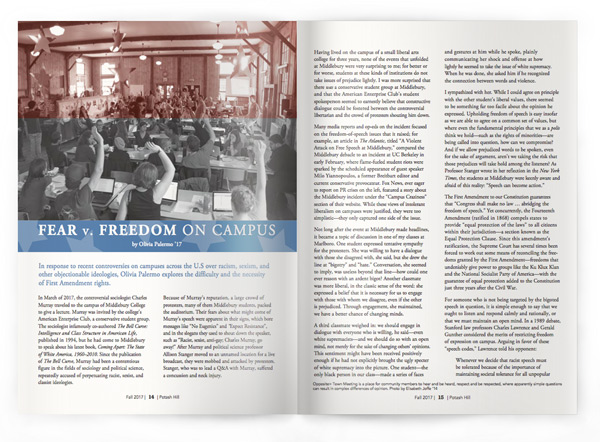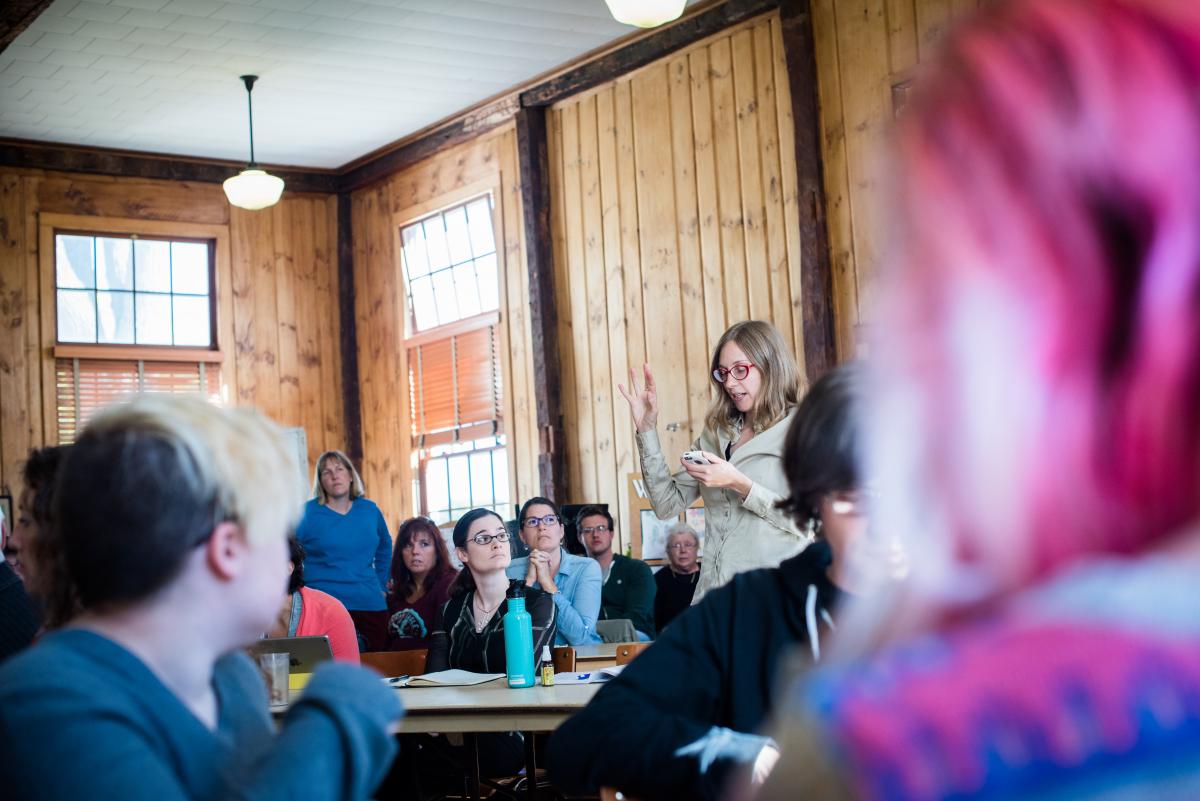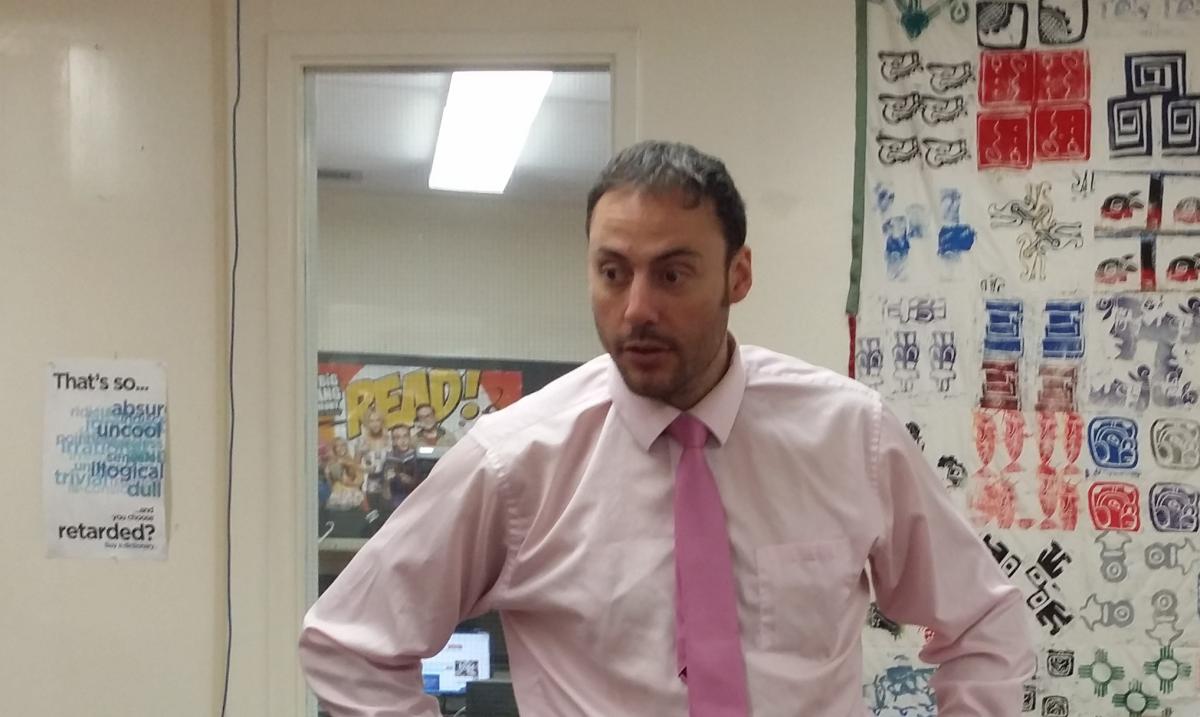Fear v. Freedom on Campus

By Olivia Palermo ’17
In response to recent controversies on campuses across the U.S over racism, sexism, and other objectionable ideologies, Olivia Palermo explores the difficulty and the necessity of First Amendment rights.

In March of 2017, the controversial sociologist Charles Murray traveled to the campus of Middlebury College to give a lecture. Murray was invited by the college’s American Enterprise Club, a conservative student group. The sociologist infamously co-authored The Bell Curve: Intelligence and Class Structure in American Life, published in 1994, but he had come to Middlebury to speak about his latest book, Coming Apart: The State of White America, 1960–2010. Since the publication of The Bell Curve, Murray had been a contentious figure in the fields of sociology and political science, repeatedly accused of perpetuating racist, sexist, and classist ideologies.
Because of Murray’s reputation, a large crowd of protesters, many of them Middlebury students, packed the auditorium. Their fears about what might come of Murray’s speech were apparent in their signs, which bore messages like “No Eugenics” and “Expect Resistance”, and in the slogans they used to shout down the speaker, such as “Racist, sexist, anti-gay; Charles Murray, go away!” After Murray and political science professor Allison Stanger moved to an unnamed location for a live broadcast, they were mobbed and attacked by protesters. Stanger, who was to lead a Q&A with Murray, suffered a concussion and neck injury.
Having lived on the campus of a small liberal arts college for three years, none of the events that unfolded at Middlebury were very surprising to me; for better or for worse, students at these kinds of institutions do not take issues of prejudice lightly. I was more surprised that there was a conservative student group at Middlebury, and that the American Enterprise Club’s student spokesperson seemed to earnestly believe that constructive dialogue could be fostered between the controversial libertarian and the crowd of protesters shouting him down.
Many media reports and op-eds on the incident focused on the freedom-of-speech issues that it raised; for example, an article in The Atlantic, titled “A Violent Attack on Free Speech at Middlebury,” compared the Middlebury debacle to an incident at UC Berkeley in early February, where flame-fueled student riots were sparked by the scheduled appearance of guest speaker Milo Yiannopoulos, a former Breitbart editor and current conservative provocateur. Fox News, ever eager to report on PR crises on the left, featured a story about the Middlebury incident under the “Campus Craziness” section of their website. While these views of intolerant liberalism on campuses were justified, they were too simplistic—they only captured one side of the issue.
 Not long after the event at Middlebury made headlines, it became a topic of discussion in one of my classes at Marlboro. One student expressed tentative sympathy for the protesters. She was willing to have a dialogue with those she disagreed with, she said, but she drew the line at “bigotry” and “hate.” Conversation, she seemed to imply, was useless beyond that line—how could one ever reason with an ardent bigot? Another classmate was more liberal, in the classic sense of the word: she expressed a belief that it is necessary for us to engage with those with whom we disagree, even if the other is prejudiced. Through engagement, she maintained, we have a better chance of changing minds.
Not long after the event at Middlebury made headlines, it became a topic of discussion in one of my classes at Marlboro. One student expressed tentative sympathy for the protesters. She was willing to have a dialogue with those she disagreed with, she said, but she drew the line at “bigotry” and “hate.” Conversation, she seemed to imply, was useless beyond that line—how could one ever reason with an ardent bigot? Another classmate was more liberal, in the classic sense of the word: she expressed a belief that it is necessary for us to engage with those with whom we disagree, even if the other is prejudiced. Through engagement, she maintained, we have a better chance of changing minds.
A third classmate weighed in: we should engage in dialogue with everyone who is willing, he said—even white supremacists—and we should do so with an open mind, not merely for the sake of changing others’ opinions. This sentiment might have been received positively enough if he had not explicitly brought the ugly specter of white supremacy into the picture. One student—the only black person in our class—made a series of faces and gestures at him while he spoke, plainly communicating her shock and offense at how lightly he seemed to take the issue of white supremacy. When he was done, she asked him if he recognized the connection between words and violence.
I sympathized with her. While I could agree on principle with the other student’s liberal values, there seemed to be something far too facile about the opinion he expressed. Upholding freedom of speech is easy insofar as we are able to agree on a common set of values, but where even the fundamental principles that we as a polis think we hold—such as the rights of minorities—are being called into question, how can we compromise? And if we allow prejudiced words to be spoken, even for the sake of argument, aren’t we taking the risk that those prejudices will take hold among the listeners? As Professor Stanger wrote in her reflection in the New York Times, the students at Middlebury were keenly aware and afraid of this reality: “Speech can become action.”
The First Amendment to our Constitution guarantees that “Congress shall make no law … abridging the freedom of speech.” Yet concurrently, the Fourteenth Amendment (ratified in 1868) compels states to provide “equal protection of the laws” to all citizens within their jurisdiction—a section known as the Equal Protection Clause. Since this amendment’s ratification, the Supreme Court has several times been forced to work out some means of reconciling the freedoms granted by the First Amendment—freedoms that undeniably give power to groups like the Ku Klux Klan and the National Socialist Party of America—with the guarantee of equal protection added to the Constitution just three years after the Civil War.
For someone who is not being targeted by the bigoted speech in question, it is simple enough to say that we ought to listen and respond calmly and rationally, or that we must maintain an open mind. In a 1989 debate, Stanford law professors Charles Lawrence and Gerald Gunther considered the merits of restricting freedom of expression on campus. Arguing in favor of these “speech codes,” Lawrence told his opponent:
 Whenever we decide that racist speech must be tolerated because of the importance of maintaining societal tolerance for all unpopular speech, we are asking blacks and other subordinated groups to bear the burden for the good of all. We must be careful that the ease with which we strike the balance against the regulation of racist speech is in no way influenced by the fact that the cost will be borne by others. We must be certain that those who will pay that price are fairly represented in our deliberations and that they are heard.
Whenever we decide that racist speech must be tolerated because of the importance of maintaining societal tolerance for all unpopular speech, we are asking blacks and other subordinated groups to bear the burden for the good of all. We must be careful that the ease with which we strike the balance against the regulation of racist speech is in no way influenced by the fact that the cost will be borne by others. We must be certain that those who will pay that price are fairly represented in our deliberations and that they are heard.
Lawrence’s argument mirrors my own thoughts upon hearing my classmate’s contentious point of view about tolerance during that heated discussion. The history of racial discrimination and harm in the United States is deeper and more traumatic than many white people understand today. In the 2003 Supreme Court case of Virginia v. Black, which focused on a Virginia law that banned cross burning, justice Clarence Thomas—the only black Justice on the Supreme Court at the time— warned Virginia’s attorney not to understate the effect of the burning cross: “This was a reign of terror and the cross was a symbol of that reign of terror.… Isn’t that significantly greater than intimidation or a threat?” The words of Lawrence and Thomas are a reminder of the gravity that certain kinds of speech can take on, even unintentionally.
Yet I fear that the ultimate consequences of restricting expression are greater than what may result from allowing it. Gunther, who was arguing against speech codes in the Stanford debate, described his experiences growing up as a Jewish person in Nazi Germany, “a country where ideological orthodoxy reigned and where the opportunity for dissent was severely limited.” I do not intend to make the argument that the United States will become akin to Nazi Germany if speech codes are allowed to remain; however, I do believe that we risk enforcing a kind of ideological orthodoxy if we permit any essential facet of our right of expression to be taken away from us, whether it is through the force of law, as in the case of ordinances against “hate speech,” or through the force of coercion, which is what the protestors at Middlebury utilized to ensure that their point of view would prevail over Murray’s. Those of us who value a liberal, democratic society should not compromise one of our fundamental constitutional rights in the belief that doing so will make us safer from harm.
What measures, then, can we resort to in order to insure that prejudicial or inaccurate views will not infect our communities? After the Middlebury incident, some writers weighed in with ideas for action that the protestors could have taken. Writing for The Chronicle of Higher Education, Catherine J. Ross explained that the Constitution “asks students, whether they’re 6 or 26, to use the traditional constitutional responses to vile speech: Walk away, don’t listen, or respond, as Justice Brandeis famously advised, with more and better speech.”
As my classmate suggested, some viewpoints— particularly the most virulent ones—cannot be reasoned with, because they do not possess any reason in themselves. In that case, Ross also suggested that students take measures similar to those of Michael K. Young, president of Texas A&M University: when the white supremacist Richard Spencer was invited to speak at the school, Young scheduled a counter-event called “Aggies United.” Young explained to an interviewer that, in his view, Spencer’s speech “doesn’t deserve a debate or protest” because “it’s beneath contempt.” Nonetheless, Young chose not to shut down Spencer’s event because he believed that his university must allow freedom of speech, even for the most contentious kinds of rhetoric.
Ultimately, the existence of the First Amendment means that there is no perfect solution to divisive or violent rhetoric; it can only be countered by protest, boycott, or “more and better speech.” Believing in the ability of speech to counter speech requires a certain amount of faith, a Lockean hope in individuals’ natural reason, which will incline them toward the common good. But even where such faith is impossible—as it may be for people in times of political upheaval—those citizens should not let fear stifle freedom.
Olivia Palermo graduated in May with a Plan of Concentration in politics. This article is excerpted and adapted from her Plan, titled “Words and the Imagination: Studies of the Effects of Rhetoric in Political Life.”
Teaching Social Justice
 Taking social action toward the common good is hard enough on college campuses, but how about in middle school? In a Capstone Project titled “Declaring War on Apathy,” Mack Neal MAT ’17 designed a digital, interactive, and experiential learning framework to counteract student indifference and encourage advocacy and action. “The curriculum specifically targets student apathy toward social issues generated by white supremacism, and engages students by making them aware of the relevance that social issues have in their lives,” says Mack, a teacher at Leland and Gray Union Middle and High School in Townshend, Vermont. “In order to create a fair and balanced society, America’s teachers have the essential responsibility to provoke and evoke critical thought, empathy, advocacy, and action from their students. They must do this by implementing relevant, socially charged curricula that reflect diverse perspectives and cultures.”
Taking social action toward the common good is hard enough on college campuses, but how about in middle school? In a Capstone Project titled “Declaring War on Apathy,” Mack Neal MAT ’17 designed a digital, interactive, and experiential learning framework to counteract student indifference and encourage advocacy and action. “The curriculum specifically targets student apathy toward social issues generated by white supremacism, and engages students by making them aware of the relevance that social issues have in their lives,” says Mack, a teacher at Leland and Gray Union Middle and High School in Townshend, Vermont. “In order to create a fair and balanced society, America’s teachers have the essential responsibility to provoke and evoke critical thought, empathy, advocacy, and action from their students. They must do this by implementing relevant, socially charged curricula that reflect diverse perspectives and cultures.”
